Beets don’t get enough respect. Let’s face it, while the leaves are striking, the roots themselves are not the most beautiful vegetable in the garden. Nevertheless, this earthy yet sweet root is easy to grow. It is full of fiber and healthy nutrients like potassium, iron, manganese, and vitamin C. What’s more, growing beets is like getting two crops for the price of one since their leaves are edible, delicious, and nutritious, too.
Beets are a member of the amaranthaceae[1] family, as are quinoa, spinach, amaranth, and Swiss chard. What many people don’t know is that the latter is a type of beet without the bulbous root.
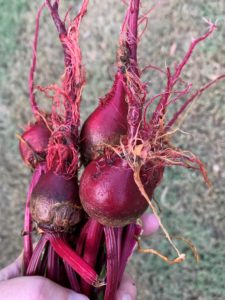
When to Plant Beets
Beets, or beetroot, as it is known outside the United States, are a cold-weather crop that can tolerate temperatures up to about 80°F (26°C), but it grows best in temperatures between 50°F to 65°F (10-18°C). You can direct sow beets two to three weeks before the last average frost date in the spring. Or, six to eight weeks before the first average frost in the fall. (If you are unsure of when your average frost dates occur, you can click on the link listed under Helpful Links on my Resource page.)
Beets, as well as crops like carrots, turnips, celery, Swiss chard, and onions, are biennial plants, meaning they don’t complete their life cycle until the second year. Thus, if you are looking to harvest seeds, you will have to wait until they flower the following year. Most growers, therefore, treat them as annuals and replant with purchased seeds each season.
Beet Seeds
Most varieties of beets have seeds that are encapsulated in a protective shell that has a jagged surface. Each seedpod houses between two and six true seeds. Some gardeners soak the seed pods in water to soften the shell, much like you would for okra seeds. (This process is called seed scarification. You can learn more about this method to increase seed germination rates in this helpful article.) Some go so far as to open the pod and extract the seeds in hopes of increasing the germination rate. But this is difficult and not necessary. If you give the seeds the right soil and the proper amount of sun and water, they should germinate. If the seeds fail to germinate, it’s possible the temperatures were too hot or too cold when the seeds were planted. Or, it is possible the seeds weren’t viable, to begin with.
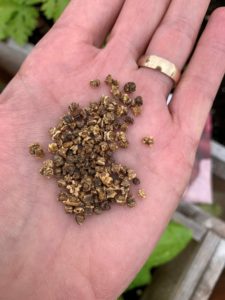
This is an affiliate link. If you make a purchase using this link, I will receive a very small commission at no additional cost to you, and it will help me maintain this website. Rest assured that I only recommend products I actually like!
Soil and Sun
Beets need deep, loose, well-draining soil that is free of rocks and debris. The soil pH level needs to be between 6.5 and 7.0 for their roots to develop properly. If you are unsure about your soil’s pH, or if you have had problems growing beets in the past, you can easily test your soil yourself. Here is the pH test kit that I use. This kit has the capability of testing nitrogen, phosphorus, potassium levels as well.
Beets require at least six hours of full sun. If they do not receive adequate sunlight, their leaves will develop, but the beet will not. It takes a lot of solar energy to develop a healthy root system, which, by the way, grows deeper than that of carrots and parsnips!
Depending on the variety, direct sow the seeds about 1/2 inch deep once the weather has warmed and the soil temperature is at least 55°F. It is important to allow two to three inches between seeds, otherwise, as the plants develop, the roots will be too close together, and proper development will be hindered. It takes between one and three weeks for the seeds to germinate, so be patient.
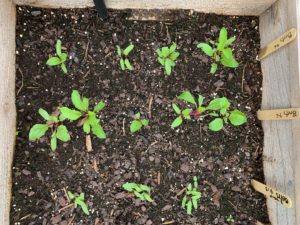
Many gardeners find success by transplanting seedlings. This may seem counterintuitive since some root crops, like carrots, should not be transplanted as the taproot, which needs to grow straight, is often disturbed when it is transplanted. Beets, on the other hand, do not have a straight taproot, but a bulbous one and therefore it will not be adversely affected if transplanted carefully.
Traditional wisdom dictates seedlings be thinned once they sprout and are about three inches tall. But another method that has grown in popularity, thanks to gardeners like Charles Dowding, maintains that since multiple beet seeds are housed in a single pod, it must mean they like to grow in groups. They suggest allowing seedlings that sprout from one pod to grow without thinning. (Dowding recommends thinning only if there are more than five seedlings.) As the seedlings mature, the beet roots will push out against one another, allowing them to fully develop. The largest of the beets in a grouping can be harvested first while the remaining beets continue to grow.
To increase your harvest, consider succession planting every three weeks. In the spring, you’ll need to stop sowing seeds about two months before the hot weather arrives because the higher temperatures will cause the roots to become tough or “woody.”
Water
Beets can be a little temperamental when it comes to watering. While they do require a decent amount of water, they cannot tolerate soggy soil. Water beets thoroughly when the soil feels dry an inch below the surface. (Note, this does not include seeds, which need to be consistently moist in order to germinate, or young seedlings.) Be careful not to overwater because wet conditions can lead to root rot. Like tomatoes, too much fluctuation in soil moisture can cause beets to crack or become woody. So it is best to be consistent in your watering.
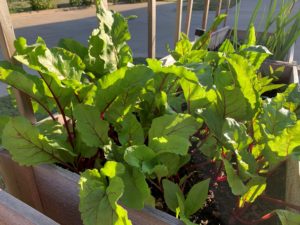
Growing Beets in Containers
If you are going to grow beets in a container, it needs to be at least 10″ deep. The diameter of the container will dictate how many beet plants you can grow per container. For example, Burpee seed company suggests growing twelve beet plants in a container that is 12″ in diameter.
If you are looking to add containers to your garden, fabric seed pots have exploded in popularity lately, and for many good reasons. One of the benefits of these pots is that the breathable fabric allows air to get to the roots, which keeps the plant from becoming root-bound. In addition, fabric pots won’t trap heat and temporarily shut down the root system as traditional pots do. Plus, the price per fabric container is less expensive when compared to conventional containers. While there are many different brands on the market, Vivosun has earned good reviews and it is competitively priced. As of this post, it ranks as the #1 seller on Amazon. The grow bags come in a variety of sizes for all your garden needs. (Fabric pot dimensions per gallon size are listed near the bottom of the Vivosun page).
Fertilizer
Root crops like beets should not be fertilized with a high nitrogen fertilizer because it will cause the plant to put its energy into growing the leaves and not the root. Instead, a fertilizer that is higher in phosphorous and potassium will help root development. If the results from the soil test kit show a phosphorous deficiency, you will need to amend the soil. One way you can do this is to add bone meal per package instructions. This organic bone meal is a trusted and affordable brand.
Harvest
Beet leaves are not only beautiful, but they are also edible! Eat them raw, juiced, or cook them as you would spinach or Swiss chard. You can harvest a few leaves at a time from each plant while they are young and about six inches tall, and therefore, more tender. In this way, the plant will still have enough leaves to allow photosynthesis and plant development, but there will be more airflow between plants to help minimize disease.
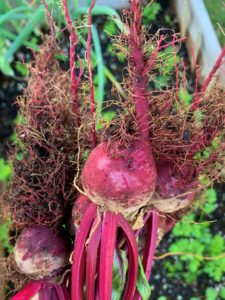
Beets take about 50 to 65 days to mature. They can be harvested at any size, large or small. Keep in mind, however, that smaller beets pack the most flavor, while larger beets tend to be more fibrous and potentially woody tasting. Once you select and harvest the size beets you want, cut off the leaves. But be sure to leave an inch of leaf stems attached to the beet, as well as the root “tail” otherwise, the beet will “bleed” a purple-red juice.
Beet leaves can be stored in the refrigerator for a few days, while the beet itself will last in the refrigerator for a few weeks. For longer-term storage, you can cook and freeze both.
Diseases
One of the more common diseases that affect beets, more specifically, beet leaves, is Cercospora leaf spot, a fungal disease that produces small, circular spots with tan or gray centers and purple margins. Sometimes the center of the spots will decay, leaving holes. To help mitigate this plant disease, prune and dispose of infected leaves as they can be a source of further infection. Be sure to wipe the blades of any cutting tools you use to keep the infection from spreading to other plants. (You can learn more about how to effectively disinfect garden tools in this helpful article.) Be careful not to overwater as damp environments can help propagate the fungus. Also, remove weeds that can harbor Cercospora and other fungal spores.
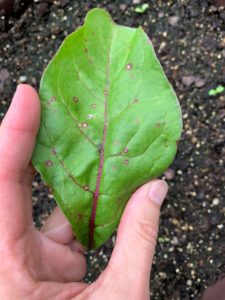
Curly top is a virus transmitted by leafhoppers. It affects a number of plants, including beets. It is characterized by leaves that twist and curl upward, as well as yellowing leaves with purple veins. Leaves will thicken or become crisp, and beets will be deformed or stunted. Remove and destroy the affected plant. Control leafhoppers by using row covers such as this one or by removing weeds where they hide.
You can also apply an insecticidal soap that is easy to make and cost-effective. Mix 1-2 teaspoons of a chemical-free Castile soap like Dr. Bronner’s or Dr. Wood’s, in one quart of water (or 1 tablespoon in one gallon of water). Add 1 to 2 teaspoons per quart (or 1 tablespoon per gallon) of a surfactant, such as vegetable oil, to help the spray stick to the plant’s surface and to reduce any suds or foam. Always do a spray test on a leaf and wait 24 to 48 hours to make sure the solution isn’t too strong. Dilute the solution if necessary, and try again. Once you have determined the solution is safe for that particular variety of beets, spray all surfaces of the plant, especially the underside of leaves. This is the sprayer I use.
Pests
Aphids are tiny insects that attack a wide variety of plants, and beets are no exception. They come in a variety of shapes, sizes, and colors, and they will literally suck the life out of your plants. They are perhaps best known for the sticky substance they secrete on plants known as honeydew. This sweet substance promotes the growth of black sooty mold and also attracts ants. The ants feed on the honeydew and, in turn, protect the aphids from any threat posed by predatory insects. You can find out more about these tiny but harmful insects and how to treat them organically in my article on aphids.
Cutworms are the caterpillar stage of a nocturnal moth. They are common pests that chew roots, leaves and cut the plant’s stem off at the soil level, hence the name. Some use a cardboard collar placed around the base of the plant and into the soil to deter them. Neem oil can also be used as an antifeedant to help deter them. You can make your own spray by mixing 1 to 2 teaspoons of pure, cold-pressed neem oil with the naturally occurring ingredient, Azadirachtin (this is the one I use), with 1/2 teaspoon of Castile soap and 1 quart of water. Again, always do a spray test on a leaf and wait 24 to 48 hours to see results before spraying the rest of the plant. Monitor the plant and apply every seven days or so. You can learn more about how to identify and get rid of cutworms in this article.
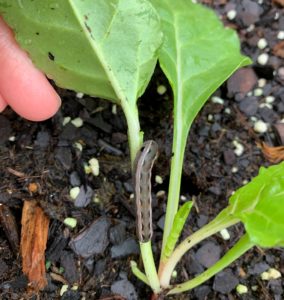
Flea beetles are small black beetles (they can also be brown, bronze, metallic gray, or iridescent blue, etc.) that eat small holes in the beet’s leaves. You know they are flea beetles because they will jump like a flea when they are disturbed. You may find flea beetle larvae feeding on the roots of seedlings and transplants. Food grade diatomaceous earth (DE) is a good remedy for these small pests. DE is the powdered remains of fossilized organisms whose micro-sharp edges scrape insects that come into contact with the powder. Sprinkle it on the plant surfaces and soil. You will have to reapply if it rains or the plant gets wet. Take care to protect your eyes, and do not inhale the powder as it can be potentially harmful.
You can also apply a homemade insecticidal soap to get rid of flea beetles. (See recipe listed above for Curly top.) For more information on how to control this pest see my article Flea Beetles: How to Identify and Treat Organically.
Cabbage loopers are voracious eaters that typically eat cruciferous vegetables, but they will attack beets as well. You can learn more about them and how to get rid of them here.
Common Problems
Cracked roots are a sign of inadequate watering. It’s important to water consistently.
Boron deficiency – Boron is a micro-nutrient that is especially necessary for crops such as brassicas and beets. Boron deficiency may be present in soils that are either too alkaline or too acidic. It is characterized by reddish leaf margins, crinkled leaves, dead leaf tips, or cork-like black spots on the roots. If you suspect your soil is lacking in boron, you will need to have it tested.
A common way to treat a boron deficiency is to add household borax. The problem is that only trace amounts are needed, and the margin between deficiency and toxicity is very thin. If the soil test comes back positive for boron deficiency, it is best to follow the testing facility’s recommendations. It may be that the safest way to remedy the problem is to add quality compost.
Poorly developed beets can be caused by a number of things including, poor soil quality and overcrowding. Find out how to remedy these and other problems that can cause beets to be undersized or deformed by reading my article: 10 Reasons Why Beets are Small or Deformed.
Varieties
There are basically two main types of beets: the traditional round or globe-shaped beets and long-rooted beets, which are shaped more like a potato. The color of beets can range from white, yellow, golden, orange, and red. The leaves can be just as colorful with white, yellow, or red veins.
Early Wonder is an heirloom variety that has been around since 1811. They produce 2″ to 3″ sweet roots with extra tall leaves. A great choice if you want to use the leaves as produce.
Detroit Dark Red beets have a beautiful deep red flesh that is milder tasting. Its 3″ roots are well suited to canning as well as roasting.
Avalanche doesn’t look like a traditional beet because its skin and flesh are white. The cultivar was an All-American Selections winner in 2015 in the Edible category. The 2″ to 3″ roots have a mild, sweet flavor.
Ruby Queen is an heirloom cultivar that grows well in poor soils. Beets are 2″ to 3″ in size, and they have a mild, sweet flavor. They are great for canning and pickling.
Golden beets are a nice variation from the standard red beet. Their skin is more of an orange-yellow, while their flesh is golden. They are milder in flavor but not quite as sweet as other varieties. One bonus to growing golden beets is that they don’t “bleed” when cut like red beets do.
Chioggia beets look like the traditional beet on the outside, but inside, they pop with red and white concentric circles. (Note, the ring pattern will fade when cooked.) Also referred to as Candy Cane beets, these heirloom beets originated in Italy and are some of the sweetest beets available.

Cylindra is a long-rooted, heirloom cultivar that is deep red and has a sweet, mild flavor. The roots grow between six and eight inches long with a diameter of one to two inches. The leaves have a slightly bitter taste when raw, so you may want to cook them before consuming them.
How to Prepare Beets
Beets are quite versatile. They can be roasted, boiled, grilled, pickled, juiced, or eaten raw by slicing or grating. Beet leaves can are great substitutes for kale or Swiss chard. They can be eaten raw, sautéed, or juiced. A quick search on the internet will provide you with countless recipes. I make a beet soup that is a gorgeous color and packed full of nutrients and taste.
Thank you for reading this article! If you found it helpful, please consider sharing it with others on social media!
[1] https://www.britannica.com/topic/list-of-plants-in-the-family-Amaranthaceae-2042049
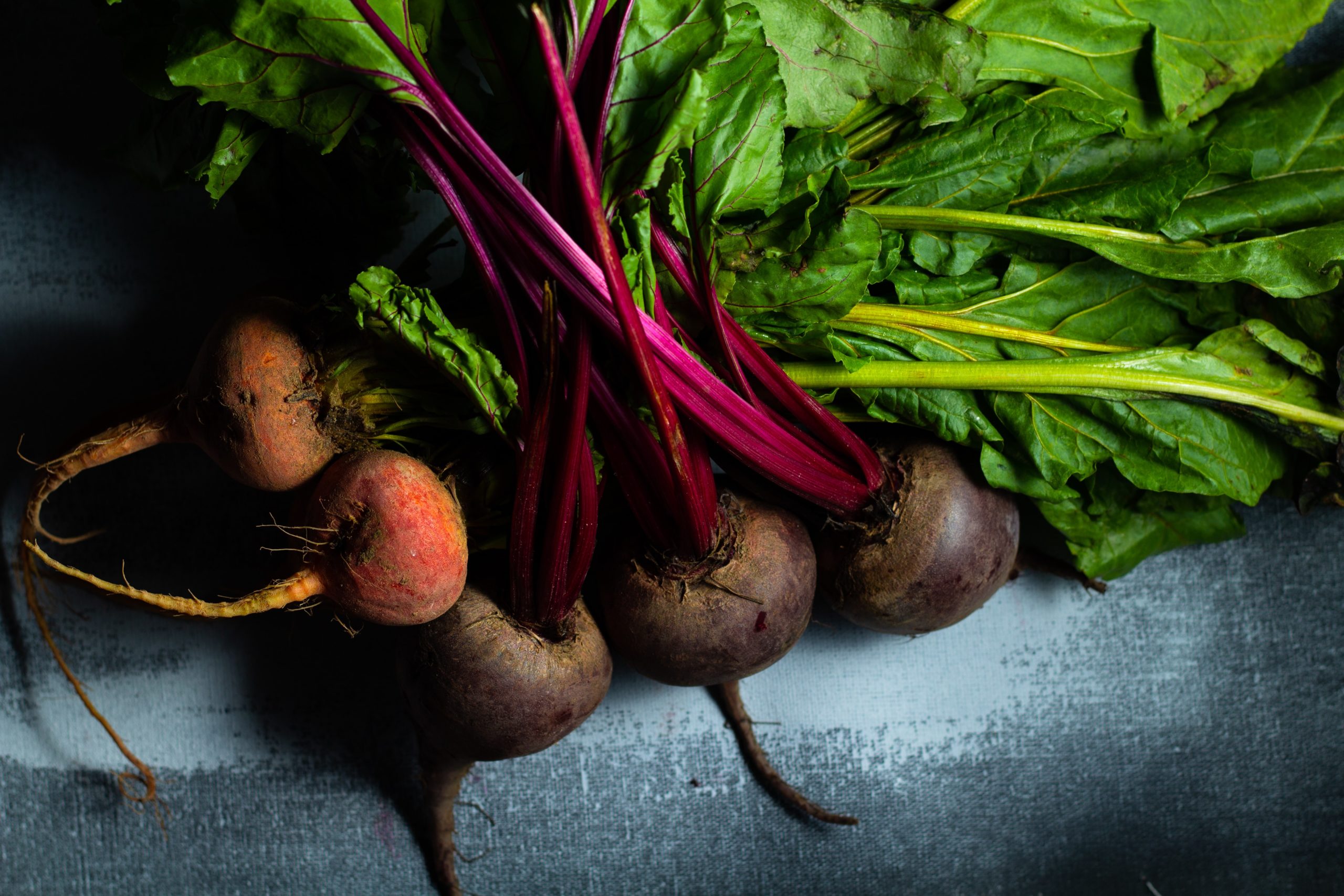
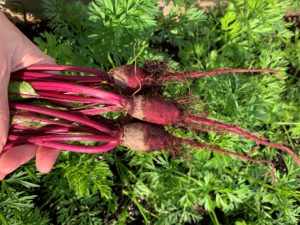
Why do my beet roots taste bitter?
Hi Renee!
Some say beets have a slightly bitter taste to begin with, some varieties more than others. But if you feel they taste more bitter than they are supposed to, it could be one of two things. First, a lack of water can cause beets to taste bitter. Second, if they have bolted or are about to, this will give them a bitter taste. Beets are not a summer crop, preferring temps 80F and below. It’s possible that the heat and a lack of water worked together to make them taste bitter. Hope this helps!